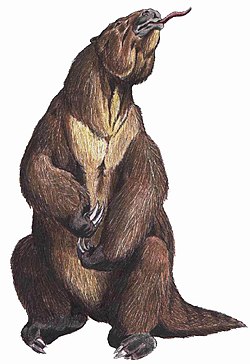Etymology
The generic name, Urumacocnus, is derived from the Urumaco Formation in which its fossils have been found in, and -ocnus, which means "hesitating" or "lazy", which is commonly used to name extinct sloths. The specific name honours Franco Urbani, for his important contributions to Venezuelan geology. [1]
Description
Urumacocnus is a relatively small sized megalonychid sloth that shares a combination of diagnostic features such as a round femur shaft, a straight femur shaft, albeit with the medial and lateral sides curved the femur head angle with respect to the femur shaft which is more than 160°, the femur neck being well demarcated, a valley between the femur head and the greater trochanter shallow; the femoral head present and larger than in other members of the family; the proximal end of the femur being broader than the distal end, greater trochanter longer than wide and smaller than the head, and entirely positioned distal to the femur head; and the lesser trochanter well developed, and caudally and medially directed. [1]
This page is based on this
Wikipedia article Text is available under the
CC BY-SA 4.0 license; additional terms may apply.
Images, videos and audio are available under their respective licenses.

